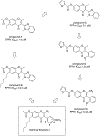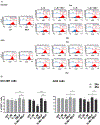Development of potent isoflavone-based formyl peptide receptor 1 (FPR1) antagonists and their effects in gastric cancer cell models
- PMID: 37839346
- PMCID: PMC10822168
- DOI: 10.1016/j.ejmech.2023.115854
Development of potent isoflavone-based formyl peptide receptor 1 (FPR1) antagonists and their effects in gastric cancer cell models
Abstract
Formyl peptide receptor-1 (FPR1) is a G protein-coupled chemoattractant receptor that plays a crucial role in the trafficking of leukocytes into the sites of bacterial infection and inflammation. Recently, FPR1 was shown to be expressed in different types of tumor cells and could play a significant role in tumor growth and invasiveness. Starting from the previously reported FPR1 antagonist 4, we have designed a new series of 4H-chromen-2-one derivatives that exhibited a substantial increase in FPR1 antagonist potency. Docking studies identified the key interactions for antagonist activity. The most potent compounds in this series (24a and 25b) were selected to study the effects of the pharmacological blockade of FPR1 in NCl-N87 and AGS gastric cancer cells. Both compounds potently inhibited cell growth through a combined effect on cell proliferation and apoptosis and reduced cell migration, while inducing an increase in angiogenesis, thus suggesting that FPR1 could play a dual role as oncogene and onco-suppressor.
Keywords: 4H-chromen-2-one derivatives; Cell growth; Docking studies; FPR1; Gastric cancer.
Copyright © 2023 The Authors. Published by Elsevier Masson SAS.. All rights reserved.
Conflict of interest statement
Declaration of competing interest The authors declare that they have no known competing financial interests or personal relationships that could have appeared to influence the work reported in this paper.
Figures











Similar articles
-
Antagonism of human formyl peptide receptor 1 (FPR1) by chromones and related isoflavones.Biochem Pharmacol. 2014 Dec 15;92(4):627-41. doi: 10.1016/j.bcp.2014.09.027. Epub 2014 Oct 17. Biochem Pharmacol. 2014. PMID: 25450672 Free PMC article.
-
The formyl peptide receptor 1 exerts a tumor suppressor function in human gastric cancer by inhibiting angiogenesis.Oncogene. 2015 Jul;34(29):3826-38. doi: 10.1038/onc.2014.309. Epub 2014 Sep 29. Oncogene. 2015. PMID: 25263443
-
Application of small molecule FPR1 antagonists in the treatment of cancers.Sci Rep. 2020 Oct 14;10(1):17249. doi: 10.1038/s41598-020-74350-z. Sci Rep. 2020. PMID: 33057069 Free PMC article.
-
Antagonism of human formyl peptide receptor 1 with natural compounds and their synthetic derivatives.Int Immunopharmacol. 2016 Aug;37:43-58. doi: 10.1016/j.intimp.2015.08.036. Epub 2015 Sep 15. Int Immunopharmacol. 2016. PMID: 26382576 Free PMC article. Review.
-
G protein-coupled receptor FPR1 as a pharmacologic target in inflammation and human glioblastoma.Int Immunopharmacol. 2012 Nov;14(3):283-8. doi: 10.1016/j.intimp.2012.07.015. Epub 2012 Aug 2. Int Immunopharmacol. 2012. PMID: 22863814 Free PMC article. Review.
Cited by
-
Targeting Neutrophil-Mediated Inflammation: Identification of Pyrazolidinone Carboxamide Derivatives as Potent Selective Inhibitors of Formyl Peptide Receptor 1 (FPR1)-Activated Neutrophils.ACS Pharmacol Transl Sci. 2025 May 2;8(6):1591-1609. doi: 10.1021/acsptsci.4c00715. eCollection 2025 Jun 13. ACS Pharmacol Transl Sci. 2025. PMID: 40534665
References
-
- Fu H, Karlsson J, Bylund J, Movitz C, Karlsson A, Dahlgren C, Ligand recognition and activation of formyl peptide receptors in neutrophils, J. Leukoc. Biol 79 (2006) 247–256. - PubMed
-
- Becker EL, Forouhar FA, Grunnet ML, Boulay F, Tardif M, Bormann BJ, Sodja D, Ye RD, Woska JR, Murphy PM, Broad immunocytochemical localization of the formylpeptide receptor in human organs, tissues, and cells, Cell Tissue Res. 292 (1998) 129–135. - PubMed
MeSH terms
Substances
Grants and funding
LinkOut - more resources
Full Text Sources
Chemical Information
Medical
Miscellaneous

